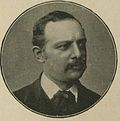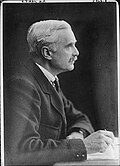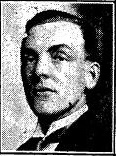Dundee (UK Parliament constituency) (original) (raw)
From Wikipedia, the free encyclopedia
Parliamentary constituency in the United Kingdom, 1868–1950
| Dundee | |
|---|---|
| Former burgh constituencyfor the House of Commons | |
| Major settlements | Dundee |
| 1832–1950 | |
| Seats | 1832–1868: One1868–1950: Two |
| Created from | Forfarshire[1] |
| Replaced by | Dundee East Dundee West |
Dundee was a constituency of the House of Commons of the Parliament of the United Kingdom from 1832 to 1950, when it was split into Dundee East and Dundee West.
From 1832 to 1868 it elected one Member of Parliament (MP) using the first-past-the-post voting system, and from 1868 until its abolition for the 1950 general election it elected two MPs using the bloc vote system.
Politics and history of the constituency
[edit]
Winston Churchill became Member of Parliament for Dundee in a by-election of 1908 soon after losing his Manchester North West seat and retained the seat until 1922.
In 1906, the explorer Ernest Shackleton unsuccessfully ran as a candidate for the Liberal Unionist Party.[2]
From its creation in 1832 the seat did not return a Conservative member until 1931 when Florence Horsbrugh was elected.[3] Originally a Liberal stronghold, the seat was one of the first in Scotland to return a Labour candidate, Alexander Wilkie, who was elected in 1906.[4]
At the 1918 general election both Churchill, still then a Liberal, and Wilkie were supported by the local Unionists, as well as their own party organisations.[5] From 1923 onwards the Conservatives/Unionists and Liberals each ran only one candidate in the constituency. This was part of an unofficial agreement between the two parties at a local level, with the understanding being that their supporters would give their other vote to the other party's candidate.[6]
The boundaries of the constituency, as set out in the Representation of the People (Scotland) Act 1832, were-
"From the Point, on the East of the Town, at which the Shore of the Firth of Tay would be cut by a straight Line to be drawn from the Tower (in Fife) of Mr. Dalgleish of Scotscraig to the Point at which the Stobsmuir Road is joined by the old Road by Stobsmuir and Clepington and the old Craigie Road, in a straight Line to the said Point at which the Stobsmuir Road is joined by the old Road by Stobsmuir and Clepington and the old Craigie Road; thence, Westward, along the old Road by Stobsmuir and Clepington to the Point called Kings Cross, at which the several Boundaries of the Parishes of Dundee, Strathmartin, and Liff meet; thence in a straight Line to a Point on the Liff Road which is distant Twelve hundred Yards (measured along the Liff Road) to the West of the Point at which the Newtyle Road leaves the same; thence in a straight Line drawn due South to the Shore of the Firth of Tay; thence along the Shore of the Firth of Tay to the Point first described."[7]
Members of Parliament
[edit]
Election results, 1832–1868
[edit]
Elections in the 1830s
[edit]
Kinloch's death caused a by-election.
Parnell was appointed as Paymaster-General of the Land Forces and Treasurer of the Navy, requiring a by-election.
Elections in the 1840s
[edit]
Elections in the 1850s
[edit]
Elections in the 1860s
[edit]
Seat increased to two members
Election results, 1873–1918
[edit]
Elections in the 1870s
[edit]
Armitstead resigned, causing a by-election.
Elections in the 1880s
[edit]
Lacita's resignation caused a by-election.
Firth's death caused a by-election.
Elections in the 1890s
[edit]
Leng
Robertson is appointed Civil Lord of the Admiralty, requiring a by-election.
Robertson
Elections in the 1900s
[edit]
Robertson
Wilkie
Shackleton
Stuart
Elections in the 1910s
[edit]
Churchill
- ^ Compared to combined Liberal vote at 1906 election
In 1918 Wilkie and Churchill were officially supported by the Dundee Unionist Party Association in addition to their own party organisations.[27]
Election results, 1922–1945
[edit]
Elections in the 1920s
[edit]
Pilkington
Gallacher
Morel
Henderson-Stewart
Elections in the 1930s
[edit]
Elections in the 1940s
[edit]
Strachey
- F. W. S. Craig, British Parliamentary Election Results 1832 - 1885
- F. W. S. Craig, British Parliamentary Election Results 1918 - 1949
- Debrett's House of Commons and the Judicial Bench 1889
- Leigh Rayment's Historical List of MPs – Constituencies beginning with "D" (part 4)
- ^ Escott, Margaret. "Forfarshire (Angus)". The History of Parliament. Retrieved 7 May 2020.
- ^ Morrell, Margot; Stephanie Capparell (2003). Shackleton's Way. Nicholas Brealey. p. 32. ISBN 1-85788-318-7.
- ^ Baxter, Kenneth (2009). "Florence Gertrude Horsbrugh The Conservative Party's forgotten first lady" (PDF). Conservative History Journal (8): 21. Retrieved 4 October 2018.
- ^ "Tracing the development of Red Scotland". Archives, Records and Artefacts at the University of Dundee. 18 October 2010. Retrieved 4 October 2018.
- ^ Baxter, Kenneth; Kenefick William (2011). "Labour Politics and the Dundee Working Class c 1895-1936". In Jim Tomlinson and Christopher A. Whatley (ed.). Jute No More. Dundee: Dundee University Press. p. 205. ISBN 978-1-84586-090-5.
- ^ Baxter, Kenneth (2009). "Florence Gertrude Horsbrugh The Conservative Party's forgotten first lady" (PDF). Conservative History Journal (8): 21–22. Retrieved 5 October 2018.
- ^ Representation of the People (Scotland) Act 1832, Schedule (M).
- ^ a b c d e f g h i Smith, Henry Stooks (1842). The Register of Parliamentary Contested Elections (Second ed.). Simpkin, Marshall & Company. pp. 199–200. Retrieved 2 September 2018 – via Google Books.
- ^ Churton, Edward (1838). The Assembled Commons or Parliamentary Biographer: 1838. p. 176. Retrieved 2 September 2018 – via Google Books.
- ^ "General Election". Morning Post. 5 July 1841. p. 2. Retrieved 2 September 2018 – via British Newspaper Archive.
- ^ McIntosh, Iain D. "Sir John Ogilvy, 9th Baronet of Inverquharity". Provincial Grand Lodge of Forfarshire. Retrieved 2 September 2018.
- ^ Hawkins, Angus (2015). Victorian Political Culture: 'Habits of Heart & Mind'. Oxford: Oxford University Press. p. 202. ISBN 978-0-19-872848-1. LCCN 2014951692. Retrieved 2 September 2018 – via Google Books.
- ^ a b c d e f g h i j k l m n o Craig, F. W. S., ed. (1977). British Parliamentary Election Results 1832-1885 (e-book) (1st ed.). London: Macmillan Press. ISBN 978-1-349-02349-3.
- ^ "Northern Warder and General Advertiser for the Counties of Fife, Perth and Forfar". 29 June 1841. p. 1. Retrieved 14 August 2019 – via British Newspaper Archive.
- ^ "Representation of Dundee". Dundee Courier. 25 March 1857. p. 4. Retrieved 2 September 2018 – via British Newspaper Archive.
- ^ "An Argument for the Ballot". Dundee Courier. 9 November 1868. p. 2. Retrieved 10 February 2018 – via British Newspaper Archive.
- ^ "Nomination of Mr Harry Scott". Northern Warder and General Advertiser for the Counties of Fife, Perth and Forfar. 20 November 1868. p. 2. Retrieved 10 February 2018 – via British Newspaper Archive.
- ^ "Our Local Elections". Dundee Courier. 29 January 1874. p. 2. Retrieved 29 December 2017 – via British Newspaper Archive.
- ^ a b c d e f g h i j British Parliamentary Election Results 1885-1918, FWS Craig
- ^ Hazel, John (1977). John W. Hazel's Book of Records. Dundee: D Winter & Son. p. 48.
- ^ Whitaker's Almanack, 1893
- ^ a b Debrett's House of Commons and the Judicial Bench, 1901
- ^ "Winston Churchill heads the poll for Dundee", The Evening Post, 20 January 1910
- ^ a b Debrett's House of Commons and the Judicial Bench, 1916
- ^ a b c Craig, FWS, ed. (1974). British Parliamentary Election Results: 1885-1918. London: Macmillan Press. ISBN 9781349022984.
- ^ The Times, 31 July 1917
- ^ Baxter, Kenneth; Kenefick William (2011). "Labour Politics and the Dundee Working Class c 1895-1936". In Jim Tomlinson and Christopher A. Whatley (ed.). Jute No More. Dundee: Dundee University Press. p. 205. ISBN 978-1-84586-090-5.
- ^ Whitaker's Almanack, 1939












